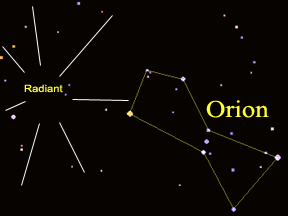Click on image for full size
Original Windows to the Universe artwork by Randy Russell.
Orionid Meteor Shower
The Orionid meteor shower happens every year in October. Meteor showers are times when you can see many meteors or "shooting stars" in one night. There are several meteor showers each year. Most meteor showers can be seen for several nights. Usually, there is one night when you can see the most meteors. That night is called the "peak" of the meteor shower. The peak of the Orionid shower is around October 21st.
During a meteor shower, it looks like all of the meteors shoot outward from one place in the sky. That point in the sky is called the "radiant" of the meteor shower. Each shower has a different radiant. The radiant for the Orionid shower is in the constellation Orion. That is why this shower is called the "Orionids".
If you want to see Orionid meteors, go outside at night on October 21st or one of the nights just before or after that date. You can see more meteors if you can watch from someplace very dark, away from street lights. If you are lucky, you might see as many as 20 meteors in an hour!
Orion does not rise into the sky in late October until about 11 PM. The best time to see Orionids is late at night. However, it is still possible to see some meteors earlier in the night. Look towards the southeast to find Orion if you live in the northern hemisphere; or look towards the northeast if you live south of the equator.
Look at these sky maps to help you find Orion if you live in the United States. The 2 AM maps for October 15th should work pretty well. If you live somewhere other than in the USA, you might want to use an interactive sky map program to help you find Orion. See the link at the bottom of this page to an interactive sky map made by "Sky & Telescope" magazine. Even if you can't find Orion, you can still see Orionid meteors. Just look up at the night sky in the southeast or northeast, depending on where in the world you live.
Most of the Orionid meteoroids are very, very small - about the size of a grain of sand! However, they are moving very, very fast - around 66 km/s (about 148,000 mph)! When they hit Earth's atmosphere, they burn up and glow; the glowing trails they leave behind for a second or two are what we see as meteors.
Can you guess where these meteors come from? They are actually dust from a comet! When a comet gets near the Sun and heats up, its ices melt and dust trapped in the ice escapes into space. The dust spreads out over the comet's orbit. When Earth crosses the comet's orbit, we run into the dust - and see a meteor shower!
The dust that makes Orionid meteors is from a very famous comet. Have you ever heard of Halley's Comet? Orionid meteors come from Halley's Comet.













